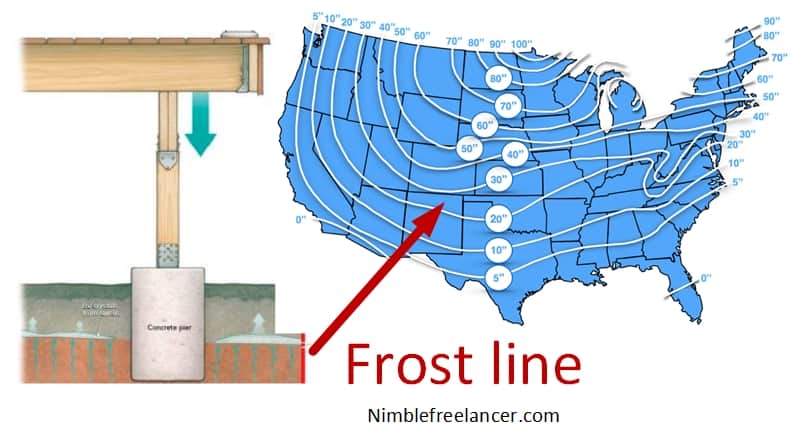Digging below the frost line is essential in ensuring a strong and secure foundation for any structure. The frost line, or the depth at which soil moisture is expected to freeze, is determined by the local climate and varies across North America.
In colder climates, footers should be placed 12-18 inches deep into the ground past the frost line to ensure that the residual heat of the earth remains consistent throughout winter months and prevents soil from freezing beneath the footers. In mild winters, 6-inch footings past the frost line are generally sufficient. Read more on our page: How Far to Dig Below Frost Line.
Please read our article about frost line depth by zip code, which shows different values for different States.

Why Do You Have to Dig Below the Frost Line?
You must dig below the frost line when installing a foundation or other underground structure to prevent damage from frost heaving. Frost heaving is a natural phenomenon when the soil freezes and expands in the winter. This expansion can exert significant pressure on underground structures, causing them to shift, crack, or collapse.
In addition to providing a secure foundation for any structure, digging below the frost line also helps protect against water damage from leaking pipes. Pipes carrying external water supply should be installed no less than 6 inches below the frost line and no less than 12 inches below grade. This helps prevent them from freezing during cold temperatures and prevents future problems associated with broken or burst pipes due to extreme cold weather.
It provides structural stability and protection against air temperatures, but digging below the frost line also helps preserve structural integrity against seismic activity over time. By embedding footings into the soil approximately one foot deeper than where they believe they’ll reach their full potential of securing the structure, engineers can rest assured that their construction will remain solid against possible earthquakes or other seismic events in the area.
Digging past what most would assume as “deep enough” provides a greater sense of security when constructing structures in areas prone to extreme temperatures or seismic activity. It may extend construction costs and completion timelines slightly; however, it should also give peace of mind knowing that your construction will remain secure far beyond what would have been foreguessed without proper research and preparation.
By excavating below the frost line, you can ensure that the foundation rests on soil not subject to freezing and thawing and, therefore, is less likely to experience frost heaving. This helps to ensure the stability and longevity of the structure and can help prevent costly damage and repairs down the road.
Additionally, digging below the frost line can help protect the foundation from changes in soil moisture caused by freezing and thawing. When soil freezes and thaws, it can become saturated with water, leading to soil erosion, settlement, and other problems. Installing the foundation below the frost line can help minimize these effects and provide a more stable base for the structure.
- Facebook Ads to Get Followers! - December 27, 2024
- ClickUp vs. Slack - December 20, 2024
- Mastering E-Commerce Analytics: A Blueprint for Success





